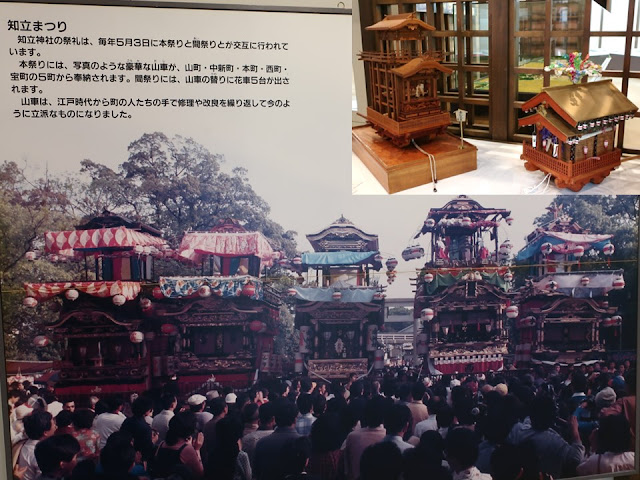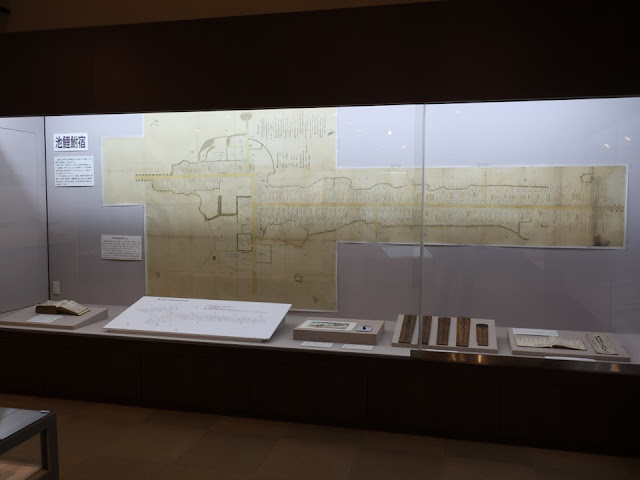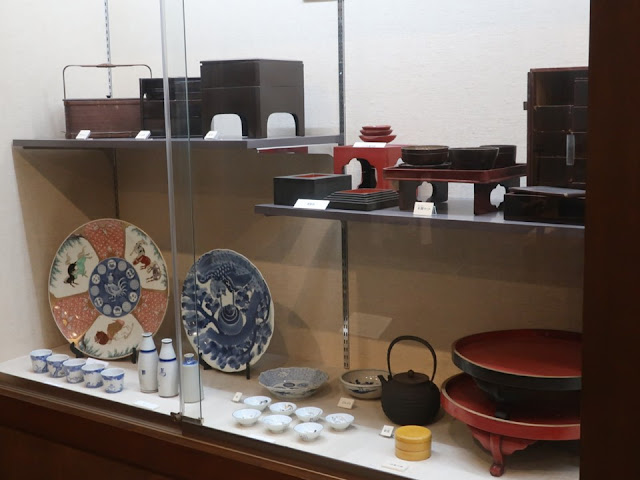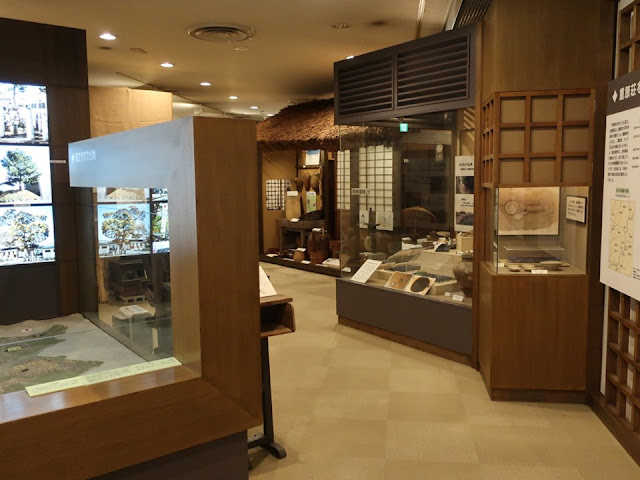Chiryu city is around 25 km southeast of Nagoya in central Japan. It was a post town of Toukaidou highway in the Edo period (1603~1868). The municipal museum comprehensibly shows the traditional festival, the defunct post town and lives. It’s new for me that the old lifestyle using straw and bamboo as materials of utensils is considered to conform to SDGs.
*SDGs: The Sustainable Development Goals
which were adopted by the United Nations is a universal call to action to end
poverty, protect the planet, and ensure that by 2030 all people enjoy peace and
prosperity.
知立市は、東海道の宿場町でした。名古屋から25kmです。祭り、宿場だったころの様子、人々の暮らし、良く分かる展示です。昔は当たり前だった竹や藁の利用をSDGsに合致しているという捉え方も新鮮でした。人々の息吹が伝わってきました。
Chiryu Shrine and Chiryu festival、知立神社と知立まつり
The exhibition begins with the most enjoyable event which is the festival. Floats, which perform traditional puppet show (Bunraku), parade in the city.
楽しいイベントから展示がスタートします。山車+文楽とからくりの賑やかなお祭りです。
Those magnificent floats have been improved since the Edo period. The festival is held on the 3rd of May.
山車の上で、文楽が演じられます。文楽の人気を窺えます。5月3日の開催です。
The records of the festival are preserved; those were written by five towns which have been approved to join it. Not only records but also complains were probably written. I’d like to read.
知立まつりに参加できる五つの町の祭礼記録。良いこと悪いこと、いろいろあったのだと思います。読んでみたいですねえ。
The movie shows us the energy of residents.
動画展示。住民のエネルギーが伝わります。
Chiryu is a famous place, because a handsome noble “Arihara no Narihira” in the 9th century is said to make a well-known short poem here.
知立の八橋は、伊勢物語(右上)の主人公とされる在原業平が立ち寄った場所として名所になりました。
Chiryu post town、宿場町知立
The post town was 1,360m long and the width of the highway was 7.2m. In 1843, there were around 250 houses which were inns, delicatessens, hardware stores and so on. Two thousand people lived.
池鯉鮒(ちりふ)宿の町並みには、長さ12町35間(1.36km)、幅4間(7.2m)の街道の両側に約250軒の家(旅籠屋、煮売屋、荒物屋など)が並び、2000人ほどが住んでいたそうです(1843年)。
The road in front of Ryounji temple remains the slight atmosphere of the old time when many people traveled on foot. There were Honjin and Waki-honjin in which exalted people such as lords stayed. The shogun took a rest at Goten which had been a castle.
了運寺前の道の写真(右上)からは、かすかに、多くの人が行き来した街道の雰囲気が感じられます。本陣、脇本陣があった場所です。御殿はかつて知立城でしたが、桶狭間の戦いで落城し、徳川将軍の休泊施設になりました。
The most important mission of post town was logistics for the government. Carriers and horses were prepared and brought documents and luggage to the next post towns. The official seal of the management office Toiyaba is exhibited (right).
物資の輸送を担う「人馬継立」が宿場の一番の役目です。もちろん、公用旅行者(侍やお公家さん)のサポートです。その運用を担う問屋場の印(右)が展示されています。絵は、藤沢宿です。
There is a full-scale model of a hatago which was an inn with meals; there were about forty inns in Chiryu. Some of them hired ladies who took care of guests.
旅籠の実物模型。食事を出す宿である旅籠は40軒ほどで、お客さんの世話をする飯盛り女を置く宿もありました。
Travel goods. There is a compass. I wonder if they walked out of highway.
旅の道具。方位磁石もありました。街道を外れてどこへ行くの、と思いました。
The wooden cage was used to carry clothes or equipment. It was covered by waterproof paper. A bar was set to bring it; two men carried it. It looks heavy. I’m sure it was a hard task.
荷物運搬用の長櫃(びつ)には、衣類や調度品を入れていました。覆いは防水用の渋紙で、棒を通して二人で担いだそうですが、長櫃だけでも重そう。大仕事です。
There is an oblong brazier beside the reception counter. Douko, which boils water and warm a bottle, is in it. I’d like to have tea.
帳場の横には長火鉢が置いてあります。灰の上には銅壺(どうこ)が置いてあって、お茶を一杯いただきたくなります。
The photo above is equipment which were used at Komaya (inn). There are two lunch boxes.
旅籠の駒屋で使っていた道具。弁当箱セットが大小二つありました。
A horse market used to be held from 25th of April to 5th of May in Chiryu. Around five hundred horses came from central Japan. Not only horse dealers but also prostitutes and actors gathered. It’s a really bustle. The picture on the left is a printing of Chiryu in the Edo period. The temple “Jigenji” on the right is the place where the horse market was held from the late 19th century to 1944.
4月25日から5月5日頃まで、宿の東で馬市場が開かれました。田植前ですね。馬は、甲斐や信濃からも来て、400~500頭になったそうです。遊女や役者も集まり、大変な賑わいだったそうです。左は二代歌川広重の「東海道 池鯉鮒」(安城市博物館)、右は明治時代から太平洋戦争が激化した昭和19年まで馬市が開かれた慈眼寺。
Travel in the Edo period、江戸時代の旅
Guidebooks at that time. 当時のガイドブックです。宿場町にちなんだ展示品ですね。
Pocket map of Japanese highways and post towns. People were able to travel if they knew the next post town and distance. I'm sure it was also useful to talk about their trip or travel plan.
懐中日本道中図。次の宿場と距離が分かれば旅をできたのですね。信頼できる街道システムです。旅の思い出や計画を語り合うのにも使えますね。
Several copies of famous printings about trip are displayed. Those shows fun things during trip and the people’s energy. On the picture above, women are competing for guests, a guest at the entrance is washing his feet. (Goyu post town in the same prefecture, Aichi)
知立宿のものではありませんが、有名な浮世絵の複製が展示されています。何れも旅の楽しさ、庶民の力を感じさせてくれます。まずは、御油(ごゆ)宿(近くの豊川市)の「旅人留め女」。客を取り合う女性の強引さ、足を洗う旅人(右側)、いいですねえ。
The title of the picture above is “Invited lady at an inn”. The ladies (prostitutes) concentrate in wearing makeup (right). Meals is being served to the guest room; a guest (left) is just out of the bath. It’s a fun time. (Akasaka post town in the same prefecture, Aichi)
次は、赤坂宿(こちらも豊川市)の「旅舎 招婦ノ図」。旅籠の様子です。左には、風呂上がりの男、食膳が運ばれてきた部屋。楽しいですね。右側の招婦(娼婦)らが、化粧に余念がない。と書かれていました。
The last one also shows an inn. It is written, “Guests are relaxing in their room. It seems the sound of insects come into the rooms”. Drinking sake (alcohol), getting a massage, it's like heaven! (Ishibe post town in Shiga Prefecture)
最後は、石部宿(滋賀県湖南市)の旅籠屋はいい雰囲気。「泊まり客らはそれぞれに部屋でくつろぎ、庭からは虫の音が聞こえてきそうです」と書かれています。お酒や按摩、最高ですね。
Exhibition room on the second floor、二階の展示室
So many artifacts of the ancient time and old utensils are displayed.
民具や古代の発掘品の展示があります。
Abundant kitchenware are also displayed.
台所道具もわんさか。
The photo, in which twelve family members eat together, attracts me. Everyone wears traditional clothes, sits down on the floor, uses their own tray (hakozen) and surrounds the hot pots in center. The meal is simple, however it should be fun time.
この写真に惹かれました。12人一緒に箱膳での食事。おかずは簡素ですが、賑やかですね。皆さん着物です。
Utensils above are made from bamboo. Its bark is used to wrap rice balls and other foods. It is very useful tree. There are many bamboo trees even until now; I think those will be used if plastic material is prohibited.
Bamboo is near at hand. It is easy to handle for production such as making basket. Moreover, the texture is likable. Plus, it’s biodegradable, so it returns to the earth after using. It is written, “We can recycle the natural material (bamboo), so it’s very earth-friendly. Bamboo is a material which conforms to one of SDG’s: Responsible Production and Consumption." I totally agree.
竹を使った生活道具。竹の皮はおにぎりや食べ物を包むのに使われました。役に立つ植物ですね。今も、あちこちに竹林がありますが、プラスチックがダメとなったら、また、大活躍だと思います。
竹は、手に入れやすく、裂いてカゴを編むなど加工しやすく、表面がつるつるで手触りが良いという特徴があります。使い終われば、自然に帰るので、「自然の資源を循環させて利用する、大変地球に優しい材料」、SDGsの「つくる責任、つかう責任」に適合したもの、と説明されています。その通りです。
It says, “Rice was the ultimate (best) recyclable resource”. The byproducts (bran, husks and straw) were utilized as shoes, clothes and so on (right). After using them, those were used as fertilizer by burning or directly burying in the ground. It’s sustainable!
The exhibitions of the historical museum changing to propose our future by old good facts. It's very fresh for me.
「稲は究極のリサイクル資源」と書かれています。お米を食べた後の、わら、もみがら、ぬかなどは、生活用品だけでなく、屋根や壁など建材、俵など包材など様々な製品になり、最後は土に戻ります。
歴史民俗資料館の展示は、将来を見据えた展示に変化しています。
The museum is in this large building which also has a library. The entrance of the museum is upper left.
図書館もある巨大施設です。左上は、資料館の入口。
Visited
in December, 2021
Official
website: https://www.city.chiryu.aichi.jp/soshiki/kyoiku/bunka/gyomu/1/index.html (in Japanese), accessed in
June, 2022
Previous post (Museum at the post town of Toukaidou in the neighboring prefecture): Yokkaichi Municipal Museum、四日市市立博物館
Next post (Museum near the same highway /Toukaidou): KARIYA city Museum of History、刈谷市歴史博物館



























Comments
Post a Comment